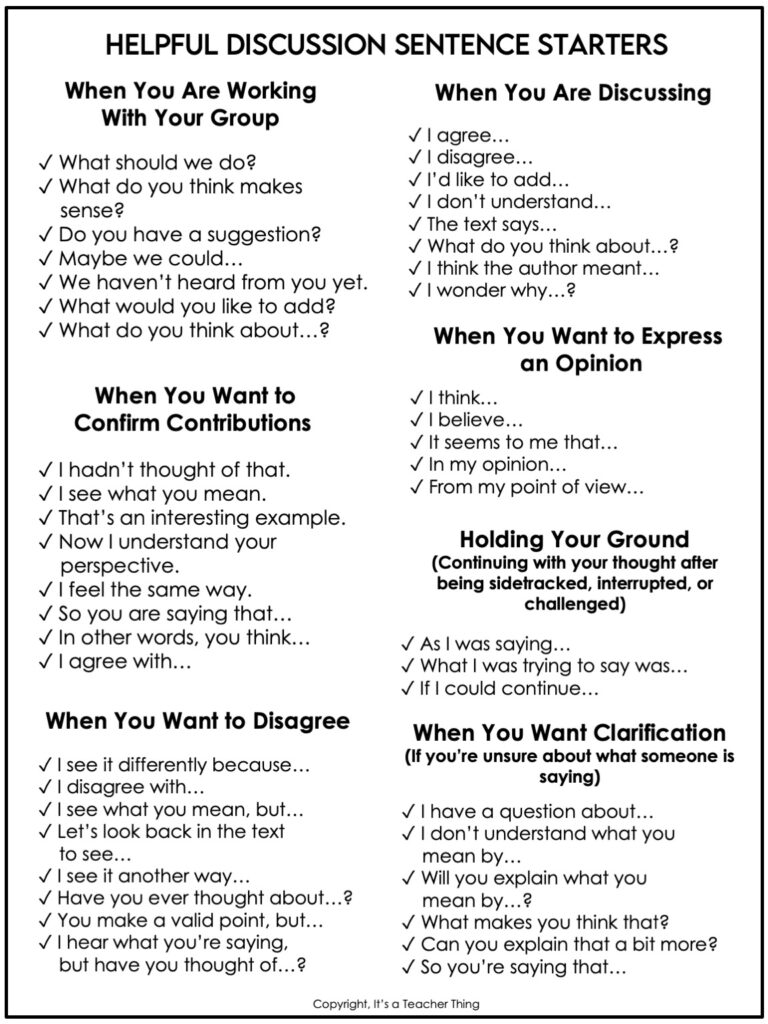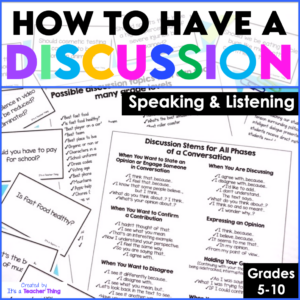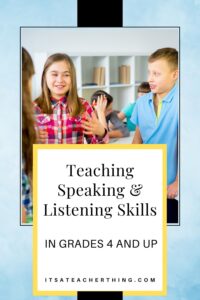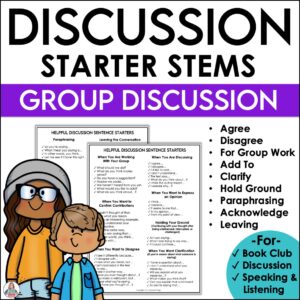Teaching speaking and listening skills helps students learn how to carry on a conversation, which is an essential life skill. With the tension surrounding politics in the United States, it’s even more important that our students receive direct instruction on how to engage in a civil conversation. Specifically, students need to practice how to agree, disagree, contribute a point of view, listen to other points of view, and attempt to understand and acknowledge other people’s ideas.

I use discussion stems to help students carry on positive interactions and to keep a conversation moving. Much of my teaching of polite discussion strategies has been focused on literature circles and debate in social studies. I have found it highly successful, but I’ve had to take the time to teach and model what positive discussion looks like. Read this blog post on the benefits of using literature circles in the classroom.
Model Speaking and Listening Skills
To practice this valuable life skill, start by modeling with another adult or have two students prepped for showing an example discussion. Pick a safe topic like the best movie this year or which restaurant has the best food. Depending on the age of the student, you may want to let them in on which participant is taking which side.
Use a list of speaking and listening stems
Project the speaking and listening stems. Make sure the headings are visible so students know which phase of discussion is taking place. Have one person state a claim. The other participant asks why the first feels this way and then listens. Paraphrasing is key. It can be difficult to make sure what is being paraphrased is what was actually said. This is where practice time is needed. The listener paraphrases what was just heard and uses a discussion stem to introduce another viewpoint. Evidence is used to support the alternate position.
Speaking and listening activities should include paraphrasing
The first person then paraphrases what they think they heard and uses an “agree or disagree” stem to state the point of view they would like to have heard. It can continue on this way for as long as you think necessary.
Show what it’s like when someone acknowledges that the other viewpoint has made an impact on the way they think about something. It is also valuable to act out what it’s like when two people can’t come to an agreement, yet they are still polite, respectful, and thank one another for the discussion.

Use speaking and listening activities that include engaging topics
I have created discussion cards with engaging topics that are done for you. The topics vary in age range, so select the appropriate cards for your students. The cards can be handed out randomly or strategically. You also may want your students to pick a topic. (For your convenience, I have left a few blank cards.)

Practice discussions can be done in pairs, small group, or whole class. I find it valuable to follow up the model discussion with a whole-class discussion. This allows more observation and practice before students participate in a less structured setting. Click here to find engaging speaking and listening activities that include topics for conversation.
Teach each phase of having a conversation
Another possibility is to pair up students and then step-by-step go through the procedure of having a discussion. Stop the class after a few minutes of practicing each phase and debrief on what just happened. Show the next set of discussion stems and have them practice using several in this next phase. This continues until you are ready to “Leave the Conversation.”
Use a class novel for speaking and listening activities
The discussion stems will help your students gain confidence in contributing to conversation and group work. I train my students to use the stems during literature circle meetings. We act out scenarios they might face during group time, and we select the best stems for the situation. Several copies of the speaking stems are placed in each group, and each student has a copy in his/her binder.
Speaking in a group setting can be challenging for many students. Additionally, carrying on a discussion wherein viewpoints differ can be stressful. Give your student the tools they need to engage in a civil manner. With stems to help them, some of the nerves dissipate and confidence increases.
I’d love to hear some of your best strategies for teaching this important, lifelong skill.
I hope you enjoy these speaking and listening activities & discussion stems freebie from It’s a Teacher Thing.
Happy teaching!
Save this post to a relevant Pinterest board for future reference.




These are truly lessons for life! Very, very, important skills and so relevant. Thanks
I totally agree. Thank you for your comments.
Thanks, Thia.
I love the structure that this provides for discussions. Many people assume that having discussions is natural for students, but many times this type of structure is exactly what they need! Great job!
Thank you! I truly appreciate your feedback. I was inspired by the week’s events, and I felt like I had to do something to encourage kindness and understanding. Thus, this post and the linked, free product were born.
Thank you. I used this a few weeks ago, and my class LOVED it! Giving kids tools
they need for this essential skill is paramount.
Marcy, your ideas and the accompanying materials are such a gold mine for teachers and students! Thank you for sharing them as freebies.
Thanks, Pat, for your sweet comment!